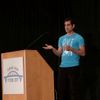Tracks
Wednesday, 17th May
- Nicole Donnelly, Tony Ojeda, Will Voorhees
Room 8
Wednesday, 17th May, 09:00 - 12:20
- Tutorials
Room 3
Wednesday, 17th May, 09:00 - 12:20
- Tutorials
Room 6
Wednesday, 17th May, 09:00 - 12:20
- Tutorials
Room 9
Wednesday, 17th May, 09:00 - 12:20
- Tutorials
Room 1
Wednesday, 17th May, 09:00 - 12:20
- Tutorials
Room 4
Wednesday, 17th May, 09:00 - 12:20
- Tutorials
Room 5
Wednesday, 17th May, 09:00 - 12:20
- Tutorials
Room 7
Wednesday, 17th May, 09:00 - 12:20
- Tutorials
Room 2
Wednesday, 17th May, 09:00 - 12:20
- Tutorials
Room 1
Wednesday, 17th May, 13:20 - 16:20
- Tutorials
Room 5
Wednesday, 17th May, 13:20 - 16:40
- Tutorials
Room 3
Wednesday, 17th May, 13:20 - 16:40
- Tutorials
Room 7
Wednesday, 17th May, 13:20 - 16:40
- Tutorials
Room 2
Wednesday, 17th May, 13:20 - 16:40
- Tutorials
Room 9
Wednesday, 17th May, 13:20 - 16:40
- Tutorials
Room 4
Wednesday, 17th May, 13:20 - 16:40
- Tutorials
Room 6
Wednesday, 17th May, 13:20 - 16:40
- Tutorials
Room 8
Wednesday, 17th May, 13:20 - 16:40
- Tutorials
Room B110-111
Wednesday, 17th May, 11:00 - 12:30
- Sponsor tutorials
Room B118-119
Wednesday, 17th May, 11:00 - 12:30
- Sponsor tutorials
Room B118-119
Wednesday, 17th May, 13:30 - 15:00
- Sponsor tutorials
![]()
- Jiao Wang
Room B110-111
Wednesday, 17th May, 13:30 - 15:00
- Sponsor tutorials
Room B110-111
Wednesday, 17th May, 15:30 - 17:00
- Sponsor tutorials
- Kelsey Hightower ( Google), Katy Huff ( University of Illinois), Jake Vanderplas ( University of Washington), Lisa Guo ( Instagram), Hui Ding ( Instagram)
University of Illinois
University of Washington
Keynotes venue
Wednesday, 17th May, 11:00 - 12:30
- Keynote
Keynotes venue
Wednesday, 17th May, 10:00 - 16:00
- Summit
Thursday, 18th May
Room 9
Thursday, 18th May, 09:00 - 12:20
- Tutorials
Room 5
Thursday, 18th May, 09:00 - 12:20
- Tutorials
Room 4
Thursday, 18th May, 09:00 - 12:20
- Tutorials
Room 3
Thursday, 18th May, 09:00 - 12:20
- Tutorials
Room 1
Thursday, 18th May, 09:00 - 12:20
- Tutorials
Room 6
Thursday, 18th May, 09:00 - 12:20
- Tutorials
- Matthias Bussonnier, Mike Bright, Min Ragan-Kelley
Room 7
Thursday, 18th May, 09:00 - 12:20
- Tutorials
Room 2
Thursday, 18th May, 09:00 - 12:20
- Tutorials
Room 8
Thursday, 18th May, 09:00 - 12:20
- Tutorials
Room 3
Thursday, 18th May, 13:20 - 16:40
- Tutorials
Room 5
Thursday, 18th May, 13:20 - 16:40
- Tutorials
Room 4
Thursday, 18th May, 13:20 - 16:40
- Tutorials
Room 6
Thursday, 18th May, 13:20 - 16:40
- Tutorials
Room 9
Thursday, 18th May, 13:20 - 16:40
- Tutorials
Room 2
Thursday, 18th May, 13:20 - 16:40
- Tutorials
Room 8
Thursday, 18th May, 13:20 - 16:40
- Tutorials
Room 7
Thursday, 18th May, 13:20 - 16:40
- Tutorials
Room 1
Thursday, 18th May, 13:20 - 16:40
- Tutorials
Room B110-111
Thursday, 18th May, 09:00 - 10:30
- Sponsor tutorials
Room B118-119
Thursday, 18th May, 11:00 - 12:30
- Sponsor tutorials
Room B110-111
Thursday, 18th May, 11:00 - 12:30
- Sponsor tutorials
Room B118-119
Thursday, 18th May, 13:30 - 15:00
- Sponsor tutorials
Room B110-111
Thursday, 18th May, 15:30 - 17:00
- Sponsor tutorials
Room B110-111
Thursday, 18th May, 15:30 - 17:00
- Sponsor tutorials
Room B118-119
Thursday, 18th May, 15:30 - 17:00
- Sponsor tutorials
Room A105-106
Thursday, 18th May, 09:00 - 17:00
- Summit
Friday, 19th May
Portland Ballroom 252-253
Friday, 19th May, 10:50 - 11:20
- Talks
Oregon Ballroom 201-202
Friday, 19th May, 10:50 - 11:20
- Talks
Portland Ballroom 251 & 258
Friday, 19th May, 10:50 - 11:20
- Talks
Oregon Ballroom 203–204
Friday, 19th May, 10:50 - 11:20
- Talks
Portland Ballroom 254-255
Friday, 19th May, 10:50 - 11:20
- Talks
- Itamar Turner-Trauring
Portland Ballroom 252–253
Friday, 19th May, 11:30 - 12:00
- Talks
Oregon Ballroom 203-204
Friday, 19th May, 11:30 - 12:00
- Talks
Oregon Ballroom 201–202
Friday, 19th May, 11:30 - 12:00
- Talks
Portland Ballroom 254–255
Friday, 19th May, 11:30 - 12:00
- Talks
Portland Ballroom 251 & 258
Friday, 19th May, 11:30 - 12:00
- Talks
Portland Ballroom 254–255
Friday, 19th May, 12:10 - 12:55
- Talks
Oregon Ballroom 201-202
Friday, 19th May, 12:10 - 12:55
- Talks
Oregon Ballroom 203-204
Friday, 19th May, 12:10 - 12:40
- Talks
Portland Ballroom 251 & 258
Friday, 19th May, 12:10 - 12:55
- Talks
Portland Ballroom 251 & 258
Friday, 19th May, 12:10 - 12:40
- Talks
Portland Ballroom 252-253
Friday, 19th May, 13:40 - 14:25
- Talks
Oregon Ballroom 203-204
Friday, 19th May, 13:40 - 14:25
- Talks
- Noah Swartz
Portland Ballroom 251 & 258
Friday, 19th May, 13:55 - 14:25
- Talks
Portland Ballroom 254-255
Friday, 19th May, 13:55 - 14:25
- Talks
Oregon Ballroom 201-202
Friday, 19th May, 13:55 - 14:25
- Talks
Oregon Ballroom 201-202
Friday, 19th May, 14:35 - 15:05
- Talks
- Jonas Neubert
Oregon Ballroom 203-204
Friday, 19th May, 14:35 - 15:05
- Talks
Portland Ballroom 252-253
Friday, 19th May, 14:35 - 15:05
- Talks
Portland Ballroom 254-255
Friday, 19th May, 14:35 - 15:05
- Talks
Room 3
Friday, 19th May, 14:35 - 15:05
- Talks
Portland Ballroom 252-253
Friday, 19th May, 15:15 - 15:45
- Talks
Portland Ballroom 251 & 258
Friday, 19th May, 15:15 - 16:00
- Talks
Oregon Ballroom 201–202
Friday, 19th May, 15:15 - 14:00
- Talks
Portland Ballroom 254-255
Friday, 19th May, 15:15 - 16:00
- Talks
Oregon Ballroom 203-204
Friday, 19th May, 15:15 - 15:45
- Talks
Portland Ballroom 251 & 258
Friday, 19th May, 15:15 - 16:00
- Talks
Oregon Ballroom 203-204
Friday, 19th May, 16:15 - 19:00
- Talks
Portland Ballroom 252–253
Friday, 19th May, 16:15 - 17:00
- Talks
Portland Ballroom 254-255
Friday, 19th May, 16:30 - 17:00
- Talks
Oregon Ballroom 201-202
Friday, 19th May, 16:30 - 17:00
- Talks
- Rebecca Bilbro
Portland Ballroom 251 & 258
Friday, 19th May, 16:30 - 17:00
- Talks
Oregon Ballroom 203–204
Friday, 19th May, 17:10 - 17:40
- Talks
Oregon Ballroom 201-202
Friday, 19th May, 17:10 - 17:40
- Talks
Portland Ballroom 254-255
Friday, 19th May, 17:10 - 17:40
- Talks
Portland Ballroom 251 & 258
Friday, 19th May, 17:10 - 17:40
- Talks
Portland Ballroom 252-253
Friday, 19th May, 17:40 - 17:40
- Talks
Saturday, 20th May
Portland Ballroom 252-253
Saturday, 20th May, 10:50 - 11:20
- Talks
Oregon Ballroom 201-202
Saturday, 20th May, 10:50 - 11:20
- Talks
Portland Ballroom 254-255
Saturday, 20th May, 10:50 - 11:20
- Talks
Portland Ballroom 251 & 258
Saturday, 20th May, 10:50 - 11:20
- Talks
Oregon Ballroom 203-204
Saturday, 20th May, 10:50 - 11:20
- Talks
Oregon Ballroom 201-202
Saturday, 20th May, 11:30 - 12:00
- Talks
Portland Ballroom 252-253
Saturday, 20th May, 11:30 - 12:00
- Talks
Portland Ballroom 251 & 258
Saturday, 20th May, 11:30 - 12:00
- Talks
Portland Ballroom 254-255
Saturday, 20th May, 11:30 - 12:00
- Talks
Oregon Ballroom 203–204
Saturday, 20th May, 11:30 - 12:00
- Talks
Oregon Ballroom 201-202
Saturday, 20th May, 12:10 - 12:55
- Talks
Portland Ballroom 252-253
Saturday, 20th May, 12:10 - 12:40
- Talks
Portland Ballroom 254-255
Saturday, 20th May, 12:10 - 12:55
- Talks
Oregon Ballroom 203-204
Saturday, 20th May, 12:10 - 12:40
- Talks
Portland Ballroom 251 & 258
Saturday, 20th May, 12:10 - 12:55
- Talks
Portland Ballroom 252-253
Saturday, 20th May, 13:40 - 14:25
- Talks
Oregon Ballroom 203-204
Saturday, 20th May, 13:40 - 14:25
- Talks
Portland Ballroom 254-255
Saturday, 20th May, 13:55 - 14:25
- Talks
Oregon Ballroom 201–202
Saturday, 20th May, 13:55 - 14:25
- Talks
Portland Ballroom 251 & 258
Saturday, 20th May, 13:55 - 14:25
- Talks
Portland Ballroom 254–255
Saturday, 20th May, 14:35 - 15:05
- Talks
Oregon Ballroom 201-202
Saturday, 20th May, 14:35 - 15:05
- Talks
Portland Ballroom 251 & 258
Saturday, 20th May, 14:35 - 15:05
- Talks
Portland Ballroom 252-253
Saturday, 20th May, 14:35 - 15:05
- Talks
Oregon Ballroom 203-204
Saturday, 20th May, 14:35 - 15:05
- Talks
Oregon Ballroom 203-204
Saturday, 20th May, 15:15 - 15:45
- Talks
Portland Ballroom 252-253
Saturday, 20th May, 15:15 - 15:45
- Talks
Portland Ballroom 254-255
Saturday, 20th May, 15:15 - 16:00
- Talks
Oregon Ballroom 201-202
Saturday, 20th May, 15:15 - 16:00
- Talks
Oregon Ballroom 201-202
Saturday, 20th May, 16:30 - 17:00
- Talks
Portland Ballroom 252-253
Saturday, 20th May, 16:30 - 17:00
- Talks
Portland Ballroom 254-255
Saturday, 20th May, 16:30 - 17:00
- Talks
Portland Ballroom 251 & 258
Saturday, 20th May, 16:30 - 17:00
- Talks
Oregon Ballroom 203-204
Saturday, 20th May, 16:30 - 17:00
- Talks
Oregon Ballroom 203-204
Saturday, 20th May, 17:10 - 17:40
- Talks
Oregon Ballroom 201-202
Saturday, 20th May, 17:10 - 17:40
- Talks
Portland Ballroom 254-255
Saturday, 20th May, 17:10 - 17:40
- Talks
Portland Ballroom 252-253
Saturday, 20th May, 17:10 - 17:40
- Talks
Portland Ballroom 251 & 258
Saturday, 20th May, 17:10 - 17:40
- Talks
Sunday, 21st May
Portland Ballroom 252-253
Sunday, 21st May, 13:10 - 13:40
- Talks
Oregon Ballroom 201-202
Sunday, 21st May, 13:10 - 13:40
- Talks
Portland Ballroom 251 & 258
Sunday, 21st May, 13:10 - 13:40
- Talks
Oregon Ballroom 203-204
Sunday, 21st May, 13:10 - 13:40
- Talks
Oregon Ballroom 203-204
Sunday, 21st May, 13:50 - 14:20
- Talks
Portland Ballroom 251 & 258
Sunday, 21st May, 13:50 - 14:20
- Talks
Portland Ballroom 254-255
Sunday, 21st May, 13:50 - 14:20
- Talks
- Kelsey Hightower ( Google)
Portland Ballroom 252-253
Sunday, 21st May, 13:50 - 14:20
- Talks
Oregon Ballroom 201-202
Sunday, 21st May, 13:50 - 14:20
- Talks
Portland Ballroom 252-253
Sunday, 21st May, 14:30 - 15:00
- Talks
Portland Ballroom 254–255
Sunday, 21st May, 14:30 - 15:00
- Talks
Oregon Ballroom 201-202
Sunday, 21st May, 14:30 - 15:00
- Talks
Portland Ballroom 251 & 258
Sunday, 21st May, 14:30 - 15:00
- Talks
Oregon Ballroom 203-204
Sunday, 21st May, 14:30 - 15:00
- Talks



































































































































